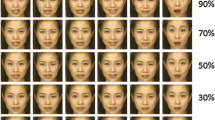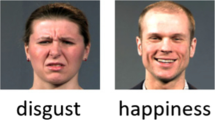Abstract
When perceiving emotional facial expressions, people with autistic spectrum disorders (ASD) appear to focus on individual facial features rather than configurations. This paper tests whether individuals with ASD use these features in a rule-based strategy of emotional perception, rather than a typical, template-based strategy by considering outcome implications of these strategies. Rule-based strategies are more tolerant of extreme stimuli than are template-based ones. Tolerance for exaggerated emotional facial expressions in individuals with ASD compared to IQ and education matched controls was tested in a forced-choice paradigm. For five of six emotions, those with ASD were more likely to accept the most exaggerated images as most realistic. People with ASD appear to rely more heavily on a rule-based strategy than a template-based strategy in perceiving emotional facial expressions.


Similar content being viewed by others
Notes
It is important to note that these participants have no time pressures. Not surprisingly, the ASD group took significantly longer to complete the session than did the control group. However, because group differences in speed of processing may be due to a variety of group differences, and due to use of many types of strategies, a group difference in time is non-diagnostic, and would tell us little about strategies used. The design of this study, therefore, makes outcome independent of processing speed.
References
Adolphs, R., Sears, L., & Piven, J. (2001). Abnormal processing of social information from faces in autism. Journal of Cognitive Neuroscience, 13, 232–240.
American Psychiatric Association. (1994). Diagnostic and statistical manual of mental disorders-IV. Washington, DC: American Psychiatric Association.
Baron-Cohen, S. (1995). Mindblindness: An essay on autism and theory of mind. Cambridge, MA: The MIT Press.
Baron-Cohen, S., Leslie, A. M., & Frith, U. (1985). Does the autistic child have a “theory of mind”? Cognition, 21, 37–46.
Baron-Cohen, S., Ring, H. A., Bullmore, E. T., Wheelwright, S., Ashwin, C., & Williams, S. C. R. (2000). The amygdala theory of autism. Neuroscience and Biobehavioral Reviews, 24, 355–364.
Baron-Cohen, S., Ring, H. A., Wheelwright, S., Bullmore, E. T., Brammer, M. J., & Simmons, A. et al. (1999). Social intelligence in the normal and autistic brain: An fMRI study. European Journal of Neuroscience, 11, 1891–1898.
Bormann-Kischkel, C., Vilsmeier, M., & Baude, B. (1995). The development of emotional concepts in autism. Journal of Child Psychology and Psychiatry and Allied Disciplines, 36, 1243–1259.
Bowler, D. M. (1992). Theory of mind in Aspergers syndrome. Journal of Child Psychology and Psychiatry and Allied Disciplines, 33, 877–893.
Braverman, M., Fein, D., Lucci, D., & Waterhouse, L. (1989). Affect comprehension in children with pervasive developmental disorders. Journal of Autism and Developmental Disorders, 19, 301–316.
Buitelaar, J. K. & Van der Wees, M. (1997). Are deficits in the decoding of affective cues and in mentalizing abilities independent? Journal of Autism and Developmental Disorders, 27, 539–556.
Buitelaar, J. K., Van der Wees, M., Swabb-Barneveld, H., & Van der Gaag, R. J. (1999). Theory of mind and emotion-recognition functioning in autistic spectrum disorders and in psychiatric control and normal children. Development and Psychopathology, 11, 39–58.
Capps, L., Yirmiya, N., & Sigman, M. (1992). Understanding of simple and complex emotions in nonretarded-children with autism. Journal of Child Psychology and Psychiatry and Allied Disciplines, 33, 1169–1182.
Celani, G., Battacchi, M. W., & Arcidiacono, L. (1999). The understanding of the emotional meaning of facial expressions in people with autism. Journal of Autism and Developmental Disorders, 29, 57–66.
Critchley, H. D., Daly, E. M., Bullmore, E. T., Williams, S. C. R., Van Amelsvoort, T., & Robertson, D. M. et al. (2000). The functional neuroanatomy of social behaviour—changes in cerebral blood flow when people with autistic disorder process facial expressions. Brain, 123, 2203–2212.
Dawson, G., Meltzoff, A., Osterling, J., Rinaldi, J., & Brown, E. (1998). Children with autism fail to orient to naturally occurring social stimuli. Journal of Autism and Developmental Disorders, 28, 479–485.
Ekman, P. (1994). Strong evidence for universals in facial expression: A reply to Russell’s mistaken critique. Psychological Bulletin, 115, 286–287.
Ekman, P., Friesen, W. V., & Ancoli, S. (1980). Facial signs of emotional experience. Journal of Personality and Social Psychology, 39, 1125–1134.
Frith, U., & Happé, F. (1994). Autism—beyond theory of mind. Cognition, 50, 115–132.
Gitelman, D. R., Parrish, T. B., Friston, K. J., & Mesulam, M. M. (2002). Functional anatomy of visual search: Regional segregations within the frontal eye fields and effective connectivity of the superior colliculus. Neuroimage, 15, 970–982.
Gitelman, D. R., Parrish, T. B., Labar, K. S., & Mesulam, M. M. (2000). Real-time monitoring of eye movements using infrared video-oculography during functional magnetic resonance imaging of the frontal eye fields. Neuroimage, 11, 58–65.
Grelotti, D. J., Gauthier, I., & Schultz, R. T. (2002). Social interest and the development of cortical face specialization: What autism teaches us about face processing. Developmental Psychobiology, 40, 213–225.
Hobson, P. (1993). Understanding persons: The role of affect. In: S. Baron-Cohen, H. Tager-Flusberg, & D. J. Cohen (Eds.), Understanding other minds: Perspective from autism (pp. 204–227). New York: Oxford University Press.
Hobson, R. P., Ouston, J., & Lee, A. (1988). What’s in a face? The case of autism. British Journal of Psychology, 79, 441–453.
Hubl, D., Bolte, S., Feineis-Matthews, S., Lanfermann, H., Federspiel, & A., Strik, W. et al. (2003). Functional imbalance of visual pathways indicates alternative face processing strategies in autism. Neurology, 61, 1232–1237.
Jolliffe, T., & Baron-Cohen, S. (1997). Are people with autism and Asperger syndrome faster than normal on the embedded figures test? Journal of Child Psychology and Psychiatry and Allied Disciplines, 38, 527–534.
Joseph, R. M., & Tanaka, J. (2002). Holistic and part-based face recognition in children with autism. Journal of Child Psychology and Psychiatry, 43, 1–14.
Kanner, L. (1943). Autistic disturbances of affective contact. Nervous Child, 2, 217–250.
Kikuchi, T., & Koga, S. (2001). Recognition of others’ and own facial expressions and production of facial expression–children and adults with autism. The Japanese Journal of Special Education, 39, 21–29.
Klin, A., Jones, W., Schultz, R., Volkmar, F., & Cohen, D. (2002). Visual fixation patterns during viewing of naturalistic social situations as predictors of social competence in individuals with autism. Archives of General Psychiatry, 59, 809–816.
Langdell, T. (1978). Recognition of faces—approach to study of autism. Journal of Child Psychology and Psychiatry and Allied Disciplines, 19, 255–268.
Light, L., Kayra-Stuart, F., & Hollander, S. (1979). Recognition memory for typical and unusual faces. Journal of Experimental Psychology: Human Memory and Learning, 5, 212–228.
Lord, C., Risi, S., Lambrecht, L., Cook, E. H., Leventhal, B. L., & DiLavore, P. C. et al. (2000). The autism diagnostic observation schedule-generic: A standard measure of social and communication deficits associated with the spectrum of autism. Journal of Autism and Developmental Disorders, 30, 205–223.
Maestro, S., Muratori, F., Cavallaro, M. C., Pei, F., Stern, D., & Golse, B. et al. (2002). Attentional skills during the first 6 months of age in autism spectrum disorder. Journal of the American Academy of Child and Adolescent Psychiatry, 41, 1239–1245.
Mottron, L., Belleville, S., & Menard, E. (1999). Local bias in autistic subjects as evidenced by graphic tasks: Perceptual hierarchization or working memory deficit? Journal of Child Psychology and Psychiatry and Allied Disciplines, 40, 743–755.
Mundy, P., & Neal, R. A. (2001). Neural plasticity, joint attention, and a transactional social-orienting model of autism. In: L. M. Glidden (Ed.), International review of research in mental retardation: Autism (pp. 139–168). San Diego, CA, US: Academic Press.
Mundy, P., & Sigman, M. (1989). The theoretical implications of joint attention deficits in autism. Development and Psychopathology, 1, 173–183.
O’Riordan, M., & Plaisted, K. (2001). Enhanced discrimination in autism. Quarterly Journal of Experimental Psychology Section A-Human Experimental Psychology, 54, 961–979.
O’Riordan, M. A., Plaisted, K. C., Driver, J., & Baron-Cohen, S. (2001). Superior visual search in autism. Journal of Experimental Psychology-Human Perception and Performance, 27, 719–730.
O’Toole, A. J., Deffenbacher, K. A., Valentin, D., & Abdi, H. (1994). Structural aspects of face recognition and the other-race effect. Memory and Cognition, 22, 208–224.
Osterling, J. & Dawson, G. (1994). Early recognition of children with autism—a study of 1st birthday home videotapes. Journal of Autism and Developmental Disorders, 24, 247–257.
Ozonoff, S., Pennington, B. F., & Rogers, S. J. (1990). Are there emotion perception deficits in young autistic children? Journal of Child Psychology and Psychiatry and Allied Disciplines, 31, 343–361.
Pierce, K., Muller, R. A., Ambrose, J., Allen, G., & Courchesne, E. (2001). Face processing occurs outside the fusiform ‘face area’ in autism: Evidence from functional MRI. Brain, 124, 2059–2073.
Plaisted, K., Saksida, L., Alcantara, J., & Weisblatt, E. (2003). Towards an understanding of the mechanisms of weak central coherence effects: Experiments in visual configural learning and auditory perception. Philosophical Transactions of the Royal Society of London Series B-Biological Sciences, 358, 375–386.
Plaisted, K., Swettenham, J., & Rees, L. (1999). Children with autism show local precedence in a divided attention task and global precedence in a selective attention task. Journal of Child Psychology and Psychiatry and Allied Disciplines, 40, 733–742.
Rogers, S. J., & Pennington, B. F. (1991). A theoretical approach to the deficits in infantile autism. Development and Psychopathology, 3, 137–162.
Schultz, R. T., Gauthier, I., Klin, A., Fulbright, R. K., Anderson, A. W., & Volkmar, F. et al. (2000). Abnormal ventral temporal cortical activity during face discrimination among individuals with autism and Asperger syndrome. Archives of General Psychiatry, 57, 331–340.
Schultz, R. T., Romanski, L. M., & Tsatsanis, K. D. (2000). Neurofunctional models of Autistic Disorder and Asperger syndrome. In: A. Klin, F. R. Volkmar, & S. S. Sparrow (Eds.), Asperger syndrome (pp. 172–209). New York: The Guilford Press.
Serra, M., Minderaa, R. B., van-Geert, P. L. C., & Jackson, A. E. (1999). Social-cognitive abilities in children with lesser variants of autism: Skill deficits or failure to apply skills? European Child and Adolescent Psychiatry, 8, 301–311.
Shah, A., & Frith, U. (1983). An islet of ability in autistic-children—a research note. Journal of Child Psychology and Psychiatry and Allied Disciplines, 24, 613–620.
Tantam, D., Monaghan, L., Nicholson, H., & Stirling, J. (1989). Autistic childrens ability to interpret faces—a research note. Journal of Child Psychology and Psychiatry and Allied Disciplines, 30, 623–630.
Valentine, T., & Bruce, V. (1986). The effect of distinctiveness in recognising and classifying faces. Perception, 15, 525–536.
Vokey, J., & Read, D. (1992). Familiarity, memorability, and the effect of typicality on the recognition of faces. Memory and Cognition, 20, 291–302.
Wing, L., & Gould, J. (1979). Severe impairments of social-interaction and associated abnormalities in children—epidemiology and classification. Journal of Autism and Developmental Disorders, 9, 11–29.
Acknowledgments
The authors wish to thank Andrea Kingdon and Justin Mattina for help with data collection, and the participants and their families for helping us with this project.
Author information
Authors and Affiliations
Corresponding author
Rights and permissions
About this article
Cite this article
Rutherford, M.D., McIntosh, D.N. Rules versus Prototype Matching: Strategies of Perception of Emotional Facial Expressions in the Autism Spectrum. J Autism Dev Disord 37, 187–196 (2007). https://doi.org/10.1007/s10803-006-0151-9
Published:
Issue Date:
DOI: https://doi.org/10.1007/s10803-006-0151-9




